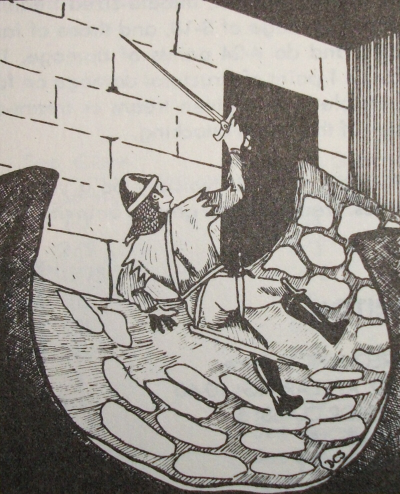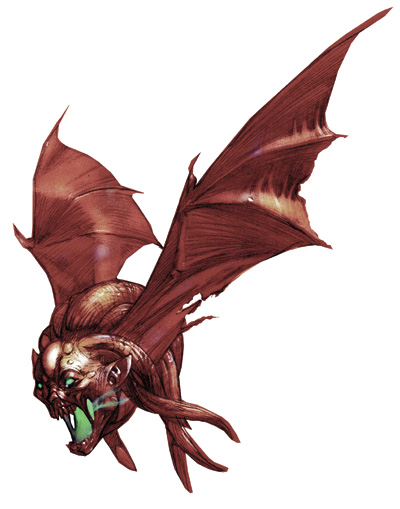Back on page five or so we had someone pop into the threat to offer some random complaints about the book; I remember that the
Tlincalli was one of the things that they were unhappy with. I’d never even heard of these guys before, so I don’t know what they used to be, but to be honest I’m liking what I see.

The Tlincalli art is quite fun. I’m a big fan of warm metallic colours, and these guys positively gleam. The artist also did a good job of making the odd anatomy work - the proportions all seem good, and I can imagine how this creature could move around and manipulate tools. But then you see the head, which is, shall we say,
irregular, and you realise that this is indeed a monstrosity, and the whole image resumes a sense of menace. Subtle but effective.
The Tlincalli are wandering desert hunters, nomads who travel in family groups and only stop for a time when the hunting in a particular area is good, or they are waiting for their eggs to hatch. Their culture is ‘austere’ and uncivilised, so I think that they just wander around and don’t trouble themselves with writing, carving art, or building structures; when they need to hide from either the night’s cold or the day’s heat, they burrow into loose sand. They can do basic metallurgy, but otherwise are at a hunter-gatherer level of technology. Their eggs receive a surprising focus here; not only are the shells poisonous, meaning that many would-be predators are paralysed by the attempt to break them, but the Tlincalli like to capture people and then leave them tied up next to the eggs, to be eaten alive upon hatching. Fun fun fun!
The other interesting thing that we learn is that the Tlincalli take their role as hunters quite seriously. If they meet a more potent hunter - a Blue Dragon is mentioned - then the tribe’s elder will need to decide whether to serve, slay, or flee the threat. All three can lead to some interesting opportunities for you, and can help to add a sense of the living ecology of the desert to your campaign. In addition, if the players fight some Tlincalli, and then learn that they were fleeing from something more powerful, that might put the fear into them! Meanwhile, simply having some of these as guards for a Blue Dragon’s lair is something that I think will be very useful for many games. I also quite like the idea of wandering tribes of these being known to live in the desert interior in a campaign; the players are forever being told to avoid ‘the deep sands’ for fear of the Tlincalli hunters. Then, naturally, the players have to
cross the deep sands for Plot Reasons; as intelligent creatures with their own language, you will have lots of opportunity to create interesting scenes as the players try to avoid, negotiate or fight their way across.
Let’s talk combat. The Tlincalli gets two attacks a turn: a
Sting, and then the choice of either
Longsword or
Spiked Chain. Since the two weapons do almost identical damage, while the Chain has a grapple effect and greater reach, I think that this is best viewed as a way to be nice or nasty to your players, giving you the option to turn down the heat by using the sword attack. The Sting is about what you’d expect - lots of poison and piercing damage, then a saving throw or be Poisoned and Paralysed. Though the saving throw is an easy one for front-line combatants, remember that Clerics do not get proficiency in Con saves, and that everyone can roll low once in a while. For that reason, if your group starts failing those checks en masse, they might find themselves in very real danger. The Longsword is just the standard option - d8 or d10. The Spiked Chain, meanwhile, does d6 and on a hit makes a target both Grappled and Restrained. That’s just nasty, especially if you do the Spiked Chain first and then follow up with the Sting. Otherwise you’ve got a monster with decent AC, good HP, and average saves; it also moves 40ft a round (but cannot burrow). All in all, these guys are a bit of a terror, and especially in groups are going to play merry hell with your players’ ability to move around the battlefield and take actions.
In essence, these guys combine the plot interest of Bedouin or Fremen, with the combat abilities of a CR 5 monster, and the visual appeal of scorpion people. I’m very happy with this statblock, and especially once you add on a couple simple variations - say, the Chieftain (an extra 50 HP and the leadership ability of the
Blade of Ilneval) and the Shaman (with the spellcasting of the War Priest) - they’ll make an excellent addition to any desert area of the campaign.
Sent from my iPad using
EN World mobile app




